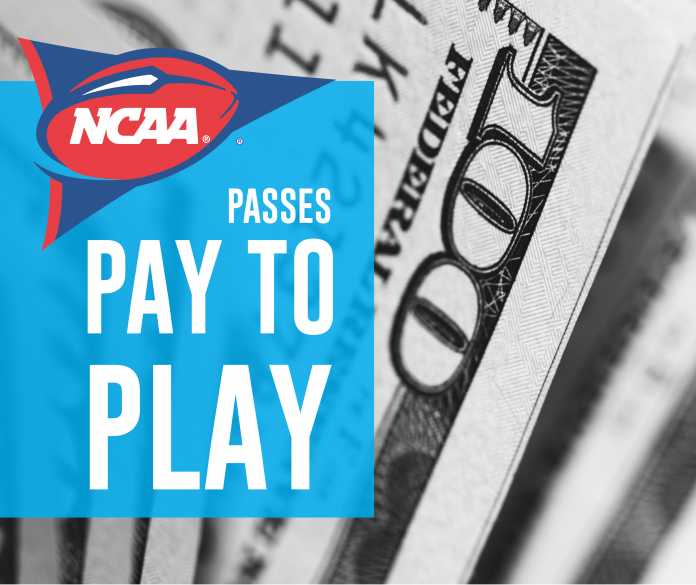The NCAA is trying to use its get-out-of-jail-free card.
Over the years, the topic of pay to play has been one of the most controversial and often discussed stories that surrounds college sports. After bills were proposed in many states to put the practice in place legally, the NCAA has ruled that it will allow college athletes to profit off of their own name and likeness “in a manner consistent of the collegiate model.”
While it remains to be seen what the “collegiate model” entails (knowing the NCAA, we’ll all be unhappy with the response), it’s a step in the right direction. They are now following the actions pushed upon them by many states.
California was the first state to pass such a law, The Fair Pay to Play Act, allowing athletes to profit off of their own name. States such as Georgia and Florida have introduced bills that would follow suit.
The NCAA has constantly been pushing back on the idea, citing reasons of competitive imbalance in the league and an unfair advantage to certain schools. The organization also cites the fear of players being taken advantage of by agents and boosters in unfair deals.
What makes the situation laughable, and true to the NCAA form of the past, is their hypocrisy. NCAA President Mark Emmert called the California bill an “existential threat” to the collegiate model less than six weeks ago, and he was prepared to rule all California schools ineligible for NCAA championships. That seems to have been a bluff the entire time.
But the tyranny of the majority has spoken, and the NCAA is now trying to get back ahead of the lawmakers and come up with a plan to turn the rules back to their advantage. This model allows the best situation for the NCAA, as they don’t want to commit salaries to players, and definitely do not want student-athletes to unionize and negotiate under their own power.
If the NCAA can create a fair process for student-athletes to profit, then there’s three major benefits to how players can prosper under NCAA legislation.
- Players who deserve to be paid will get paid.
The biggest debate to the fair pay arguments was the question of how the NCAA would balance the money. Would there be a salary cap, so teams such as Alabama can’t buy all of the best players? Who is deciding who makes the money? Is income based on value to the school or value to the team?
These factors made fair pay a slippery slope the NCAA carefully avoided for a long time. Now, the new ruling takes a lot of responsibility out of the committee’s hands. Players will now be their own entrepreneurs, making their own deals and being able to generate their own income fairly. The only stipulation the NCAA listed was that any profit must stay “consistent with the collegiate model.”
The way this decision works out is if players become savvy business people, learning how to profit off of their own talents. The top players who drive substantial income to the universities (the best players and biggest names in their respective sports) will now be able to earn what they feel they deserve, and many of them will profit. Duke basketball star and NBA No. 1 draft pick Zion Williamson would’ve been a seven-figure athlete while in college, for example, if he were able to profit off of his own image.
The biggest task of the NCAA will be to keep the competitive balance, which is something the organization highlighted in its press release. New rules are constantly taken advantage of, and if players have a way to profit more off of going to the top five schools, they’re going to take advantage of that opportunity. The NCAA will have to ensure that other schools aren’t falling behind due to the ruling.
- The NCAA no longer has to punish schools for minor monetary exchanges.
In 2010, University of Georgia wide receiver A.J. Green was suspended for four games for selling his game-worn jersey for $1,000. Later that year, star quarterback Terrelle Pryor and four teammates at Ohio State were suspended for five games for trading game memorabilia and championship rings for tattoos.
These rulings would arise year after year, and the committee had to come up with decisions on situations that had nothing to do with performance on the field. Now, that job becomes a lot easier. Granted, the NCAA will still have its fair share of investigations to resolve, but they can now focus on monitoring the schools and not its players.
Many collegiate athletes were making money anyway and doing it in secret. University athletic programs were derailed based on some of these rulings, and now, with less responsibility, we can all worry less about how players are secretly getting money.
- All parties win.
Once again, this is a situation where all parties feel like they can walk away with a victory. For the players, it is a great step toward what they feel is fair compensation for their worth on the field. Many players will rejoice at the opportunity to profit off of themselves, and it is a model that still promotes what college is all about: growing oneself.
Teaching these athletes to grow their brand at 18 years old can go a long way to helping that down the line, especially when some of the student-athletes reach a professional level. They’ll have the ability to understand their self worth and can avoid being taken advantage of without the NCAA having their backs.
It was a monumental decision for the NCAA to allow college athletes to profit off of their own likenesses. As more information unfolds on the rule changes and how it will be installed, we’ll see a plan in place that will protect the players, while still allowing them to feel as though it’s them, and not their universities, that reap the benefits of their hard work on the field.



